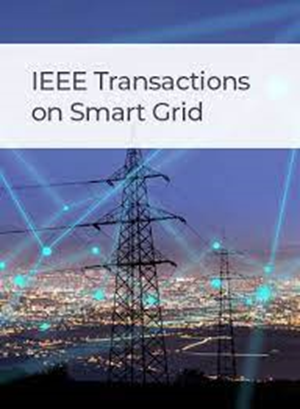A Probabilistic Graphical Model for Predicting Cascade Failures of Electric Vehicle Charging Networks Caused by Hurricanes
IF 8.6
1区 工程技术
Q1 ENGINEERING, ELECTRICAL & ELECTRONIC
引用次数: 0
Abstract
Electric vehicle charging networks (EVCNs) are vulnerable to power outages. The resilience of critical charging infrastructures is vital for providing uninterrupted service. When a hurricane occurs, the offline charging stations (CSs) may cause the redistribution of EV traffic flow, resulting in the congestion at the healthy CSs and potentially leading to a cascade failure. This paper presents a probabilistic graphical modeling (PGM) framework for predicting the hurricane-induced cascading failures of EVCNs. A Bayesian network is proposed to capture the relationships between a hurricane, the power and traffic systems coupled by an EVCN. An AC-based Cascading Failure model (ACCF) is established to simulate the line overloading and load shedding. EV load redistribution is formulated as a traffic assignment problem considering the road impedance between the nearby CSs. The proposed PGM is trained by the Expectation-Maximization (EM) algorithm considering the traffic flow as the hidden variable. Clique tree method is used to infer the propagation probability of cascading failure. The case study demonstrates the causal relationship between hazards and cascading failures of EVCNs under different hurricane scenarios. Results show that the proposed method can predict the propagation of cascading failures in EVCNs by identifying and quantifying the correlation among the susceptible CSs.预测飓风导致电动汽车充电网络连锁故障的概率图形模型
电动汽车充电网络(EVCNs)容易受到停电的影响。关键充电基础设施的弹性对于提供不间断的服务至关重要。当飓风发生时,离线充电站可能会引起电动汽车流量的重新分配,导致健康充电站的拥堵,并可能导致级联故障。本文提出了一种预测EVCNs级联故障的概率图形建模框架。提出了一种贝叶斯网络来捕捉由EVCN耦合的飓风、电力和交通系统之间的关系。建立了一种基于交流的级联故障模型(ACCF)来模拟线路过载和减载。将电动汽车负载再分配问题表述为考虑附近CSs之间道路阻抗的交通分配问题。该模型以交通流为隐变量,采用期望最大化算法进行训练。采用团树法推导了级联故障的传播概率。案例研究表明,在不同的飓风情景下,EVCNs的危害与级联失效之间存在因果关系。结果表明,该方法通过识别和量化易感节点之间的相关性,可以预测EVCNs中级联故障的传播。
本文章由计算机程序翻译,如有差异,请以英文原文为准。
求助全文
约1分钟内获得全文
求助全文
来源期刊

IEEE Transactions on Smart Grid
ENGINEERING, ELECTRICAL & ELECTRONIC-
CiteScore
22.10
自引率
9.40%
发文量
526
审稿时长
6 months
期刊介绍:
The IEEE Transactions on Smart Grid is a multidisciplinary journal that focuses on research and development in the field of smart grid technology. It covers various aspects of the smart grid, including energy networks, prosumers (consumers who also produce energy), electric transportation, distributed energy resources, and communications. The journal also addresses the integration of microgrids and active distribution networks with transmission systems. It publishes original research on smart grid theories and principles, including technologies and systems for demand response, Advance Metering Infrastructure, cyber-physical systems, multi-energy systems, transactive energy, data analytics, and electric vehicle integration. Additionally, the journal considers surveys of existing work on the smart grid that propose new perspectives on the history and future of intelligent and active grids.
 求助内容:
求助内容: 应助结果提醒方式:
应助结果提醒方式:


